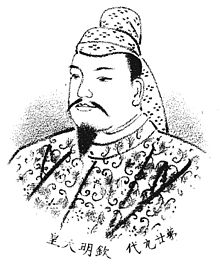29th Emperor of Japan From Wikipedia, the free encyclopedia
Emperor Kinmei (欽明天皇, Kinmei-tennō, 509–571), also written as Kimmei, was the 29th emperor of Japan,[1] according to the traditional order of succession.[2] His reign started in 540 and ended in 571.[3] Historians consider details about the life of Emperor Kinmei to be possibly legendary, but probable.[4] The name Kimmu-tennō was created for him posthumously by later generations.
| Kinmei | |
|---|---|
 | |
| Emperor of Japan | |
| Reign | December 5, 539 – April 15, 571 |
| Predecessor | Senka |
| Successor | Bidatsu |
| Born | 509 |
| Died | April 15, 571 (aged 62) |
| Burial | Hinokuma no saki Ai no misasagi (Nara) |
| Spouse | Ishi-Hime Kura Wayaka-Hime Hikage Soga no Kitashihime Soga no Oane Hime Nukako no Iratsume |
| Issue Among others... | Emperor Bidatsu Emperor Yōmei Emperor Sushun Empress Suiko |
| House | Yamato |
| Father | Emperor Keitai |
| Mother | Princess Tashiraka no Himemiko |
The conventionally accepted names and sequence of the early emperors were not to be confirmed as "traditional" until the reign of Emperor Kammu, who was the 50th monarch of the Yamato dynasty.[5]
Emperor Kinmei's father was Emperor Keitai and his mother was Emperor Ninken's daughter, Princess Tashiraka (手白香皇女, Tashiraka Ōjo).[6] He was the third son; and his older brother was Emperor Senka.
Kinmei had six wives and 25 Imperial children (16 sons and 9 daughters).[6]
Kinmei established his court at Shikishima no Kanazashi (磯城嶋金刺宮) in Yamato.[6]
Kinmei's reign was marked by the introduction of Buddhism in Japan. The King of Kudara in Korea sent the emperor gifts of Buddhist scripture and a statue of the Buddha.[10]
In this reign, the emperor's chief ministers were:
This emperor's official name after his death (his posthumous name) was regularized many centuries after the lifetime which was ascribed to Kinmei.[11]
According to the Imperial Household Agency, the emperor's final resting place is in an earthen tumulus (kofun). Kinmei is venerated at a memorial Shinto shrine (misasagi) which is associated with the burial mound.[1]
Seamless Wikipedia browsing. On steroids.
Every time you click a link to Wikipedia, Wiktionary or Wikiquote in your browser's search results, it will show the modern Wikiwand interface.
Wikiwand extension is a five stars, simple, with minimum permission required to keep your browsing private, safe and transparent.